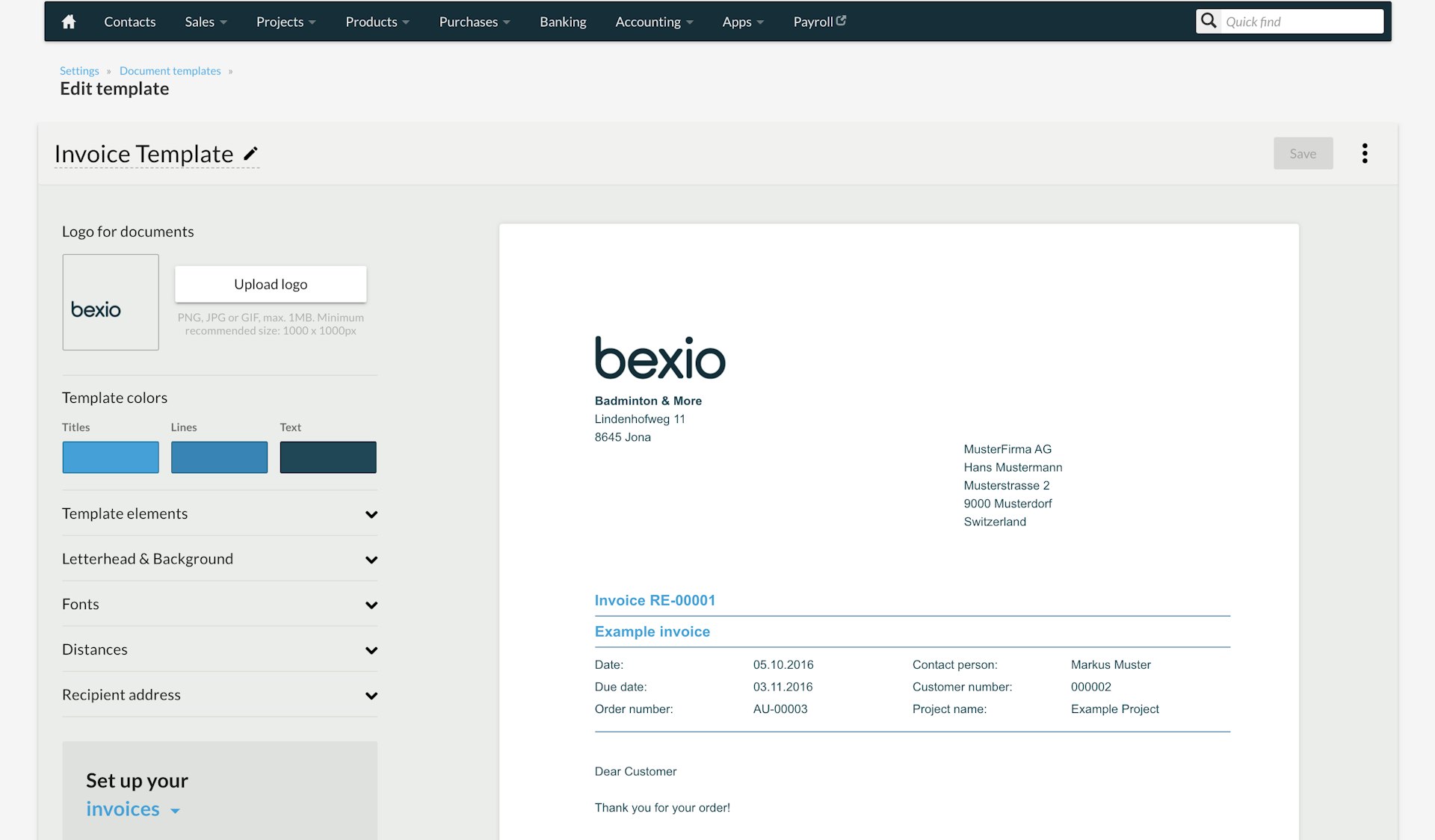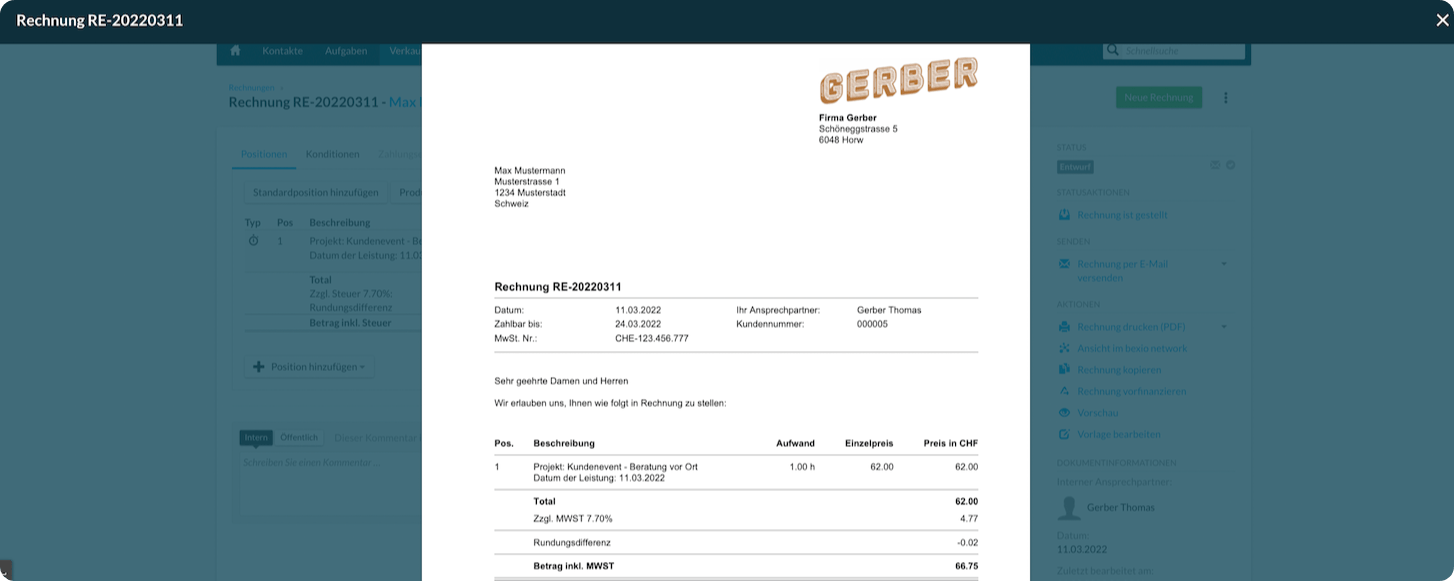The invoice number is a crucial part of every invoice: they consist of a unique combination of numbers, letters and hyphens, making it possible to easily match a payment or transfer to the business transaction in question. This post will tell you everything you need to know about invoice numbers.

What is an invoice number?
Invoice numbers are usually consecutive and consist of either digits or a combination of digits, letters and hyphens. Each number is unique in the accounting system and can be created manually or automatically using invoicing software.
In this article:
- How to create invoice numbers correctly
- Examples of invoice numbers
- Do invoice numbers have to be consecutive?
- Where does the invoice number go?
- Is an invoice without an invoice number valid?
- Invoice number used twice – what do I do?
- How do I correct an error in the invoice number?
- FAQ: Frequently asked questions about invoice numbers
How to create invoice numbers correctly
Invoice numbers can't be used more than once – every invoice has to have its own unique invoice number.
As a rule, invoice numbers should also follow a comprehensible logic – for example, they can consist of a combination of the year, the customer number and a serial number. These serial numbers can go on indefinitely (e.g., each customer has their own serial number range) or start over again every year (e.g., a range of serial numbers for all invoices). In the latter case, the range of numbers concludes at the end of the year, and a new one starts.
Examples of invoice numbers
An invoice number might include the year, the customer number and a combination of digits, letters and hyphens. Here are a few examples:
Invoice no.: IN-2022-K2-03
In this example, the invoice starts with the abbreviation 'IN'; followed by the year of issue, 2022; the customer number, 2; and then the number '03', indicating that this is this customer's third invoice this year. This format is particularly easy to understand and flexible.
Invoice no.: 2022-2905-1799-M12345
This invoice number includes the year, 2022; the date, 29/05; the customer number, 1799; and a serial number, which might also contain letters. This format can make it much easier to find the supporting document in the event of complaints or queries.
Invoice no.: INVOICE-RECIPIENT_2022_013
This invoice number starts with the name of the invoice recipient followed by the current year, and, then, in this example, it's the thirteenth invoice. Since the invoice recipient is placed at the beginning, this kind of invoice number is clear and easy to find in an electronic storage system.
Do invoice numbers have to be consecutive?
Even if most invoicing software tend to assign serial invoice numbers, this isn't obligatory. The only important thing is that the number is unique so that the invoice can be matched to one business transaction. Serial invoice numbers make sense, though, because they make it easier to maintain an overview of your invoices and quickly spot if one is missing.
As already mentioned above, there are several ways to use serial numbers. For example, you can specify a separate number sequence for each customer, which will keep on going uninterrupted every year. Otherwise, you can define a general serial number range for all your invoices, starting from '1' again at the start of the new year so that your invoice numbers stay manageable.
In any case, it's important to update the year in your invoice numbers at the turn of the year. Many accounting programs require you to do this once at the start of the new year. With bexio, this is automatic – you can compose the invoice number yourself with the help of placeholders, which means the year can be changed without any extra work.
For example: Mr R. sends an invoice to Ms E. with the invoice number IN-2022-012 at the end of December 2022. In January 2023, another invoice follows with the invoice number IN-2023-013. Alternatively, Mr R. could also have closed the number range at the turn of the year and started at '001' again in January, giving IN-2023-001.
Where does the invoice number go?
An invoice number should be clearly visible. It is often placed under the address or as the title of the document (e.g., 'Invoice IN-2022-012'). It should be clearly visible, so formatted in a larger font and/or bold.
It should also be easily recognisable as the invoice number, and not the order, reference or customer number. With a good invoicing software, though, you don't have to worry about this, as pre-set invoice templates usually comply with legal requirements. In invoices created with bexio, for example, the invoice number is easy to spot in the title:
Is an invoice without an invoice number valid?
The Swiss SME Portal doesn't mention invoice numbers as part of the statutory minimum information, but adding an invoice number is common practice in Switzerland. As mentioned above, they make it easier to request and make payments as well as to send reminders.
However, since assigning an invoice number is not obligatory in Switzerland, a private invoice, for example, can also easily be created without an invoice number. This is because, as a rule, other elements, such as the service provider, customer, type of service, date and addresses of both partners, make it easy to match the invoice to the business transaction even without an invoice number.
Invoice number used twice – what do I do?
A duplicated invoice number, whether sent to the same or two different customers, can make clarifications more difficult and even delay payment. Electronic systems might refuse to settle an invoice with a duplicated number, making manual intervention necessary.
If you use a word processor to create invoices and have to manually change invoice numbers every time, it's particularly easy to accidentally use an invoice number twice. This is frustrating and can happen to anyone, but it can easily be avoided by using an invoicing software.
In any case, you need to inform the customer(s) in question about the error and send them a corrected invoice. You can find out how to do this in the next section.
How do I correct an error in the invoice number?
If you notice an error in the invoice number, it is a good idea to immediately create a new invoice with the correct invoice number and send the replacement invoice to the customer, because when the time comes to perform an audit, any numbers that are duplicated or out of sequence can raise questions.
However, if you only notice an error in the invoice number after the invoice has already been settled, it may not be quite as easy to change as the business transaction is considered closed. In this case, you should cancel the invoice. The reverse invoice will be for a negative amount that offsets the incorrect invoice. You can then issue a new invoice with a new invoice number.
Here's how easy it is to create invoices in bexio
- Customise the template just once: with just a few simple clicks, you can customise your invoicing template however you like – change the layout and design, and insert your logo and your own letterhead to make it look professional.
- Invoice number: serial invoice numbers are generated automatically. You don't have to worry about the billing address either – you only have to add the customer data to the central address book once. When you create an invoice, you only select the customer, and all relevant data will automatically be imported into your invoice.
- Insert services or products: once you have added services or products to the central product catalogue, they can easily be inserted into your invoices with just a click. You can even import time-tracking details into your invoices.
- Check and send the invoice: with bexio, you'll never forget important information again – because details like invoice numbers and addresses are inserted automatically. You can then send your paper invoice by post or by email as a PDF, which is also easy to do from your bexio account.

FAQ: Frequently asked questions about invoice numbers
No, invoice numbers and order numbers are not the same thing. The order number is used to identify an order and is meant to ensure that the customer receives exactly what they ordered. The invoice number, on the other hand, is the number that identifies the invoice – i.e., the request for payment.
When you send an invoice to a friend in Switzerland, you don't necessarily have to create an invoice number. As a rule, other elements, such as the service provider, customer, type of service, date and addresses of both partners mean a one-off invoice can easily be matched up to the business transaction without an invoice number.
In theory, the order number can also be used as an invoice number, provided it is unique to the customer and delivery. However, if, for example, you have received a longer-term order from a customer and issue invoices regularly, the order number remains unchanged, but a new invoice number still needs to be created for each invoice.
Since invoice numbers are not obligatory in Switzerland, there are no rules about special characters. However, since invoice numbers also need to be read electronically, we advise against using special characters. Hyphens are common in invoice numbers and are used to structure them (e.g., 'RE-2022-001').
Test out bexio now for 30 days free of charge and with no obligation
Test all the features of bexio, the simple business software for your SME administration.





